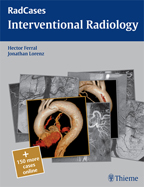|
|
|
| |
 |
|
|

|
 推薦指數:
推薦指數:





|
|
- 內容介紹
|
Interventional Radiology
Hector Ferral (Author), Jonathan Lorenz (Author)
2010
224 pp, 493 illustrations
softcover
ISBN (Americas): 9781604061772
ISBN (EUR, Asia, Africa, AUS): 9781604061772
All the key Radiology cases for your rounds, rotations, and exams -- in print and online!
RadCases contains cases selected to simulate everything that you'll see on your rounds, rotations, and exams. RadCases also helps you identify the correct differential diagnosis for each case - including the most critical.
Visit RadCases.thieme.com for free sample cases and to experience this dynamic learning tool for yourself!
RadCases covers:
Cardiac Imaging, Interventional Radiology, Musculoskeletal Radiology, Neuro Imaging, Thoracic Imaging, Pediatric Imaging, Gastrointestinal Imaging, Breast Imaging, Nuclear Medicine, Ultrasound Imaging, Head and Neck Imaging, Genitourinary Imaging
Each RadCases title features 100 carefully selected, must-know cases documented with clear, high-quality radiographs. The organization provides maximum ease of use for self-assessment.
Each case begins with the clinical presentation on the right-hand page; simply turn the page for imaging findings, differential diagnoses, the definitive diagnosis, essential facts, and more.
Each RadCases title includes a scratch-off code that allows 12 months of access to a searchable online database of all 100 cases from the book plus an additional 150 cases in that book's specialty - 250 cases in total!
Learn your cases, diagnose with confidence and pass your exams. RadCases.
Interventional Radiology will enable you to diagnose the full range of vascular and nonvascular cases.
Features of Interventional Radiology:
•Numerous high-resolution 3-D radiographs demonstrating the mechanics of the vascular system
•A variety of common and uncommon presentations covering everything from acute lower gastrointestinal bleeding to superficial femoral artery stenosis
•Examples of critical cases that must be diagnosed immediately -- to avert potential disaster in daily practice and on exams -- such as traumatic injury of the aorta
|
|
|

